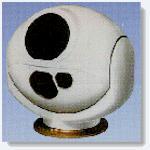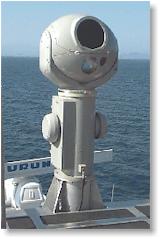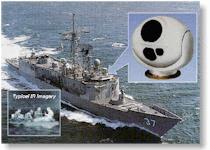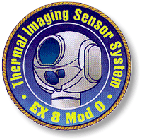





 The Thermal Imaging Sensor System (TISS) AN/SAY-1 is a stabilized imaging system which provides a visual infrared (IR) and television image to assist operators in identifying a target by its contrast or infrared characteristics. The AN/SAY-1 detects, recognizes, laser ranges, and automatically tracks targets under day, night, or reduced visibility conditions, complementing and augmenting existing shipboard sensors. The AN/SAY-1 is a manually operated system which can receive designations from the command system and designate to the command system providing azimuth, elevation, and range for low cross section air targets, floating mines, fast attack boats, navigation operations, and search and rescue missions. The sensor suite consists of a high-resolution Thermal Imaging Sensor (TIS), two Charged Coupled Devices (CCDs) daylight imaging Television Sensors (TVS), and an Eye-Safe Laser Range Finder (ESLRF). The AN/SAY-1 also incorporates an Automatic Video Tracker (AVT) that is capable of tracking up to two targets within the TISS field of view.
The Thermal Imaging Sensor System (TISS) AN/SAY-1 is a stabilized imaging system which provides a visual infrared (IR) and television image to assist operators in identifying a target by its contrast or infrared characteristics. The AN/SAY-1 detects, recognizes, laser ranges, and automatically tracks targets under day, night, or reduced visibility conditions, complementing and augmenting existing shipboard sensors. The AN/SAY-1 is a manually operated system which can receive designations from the command system and designate to the command system providing azimuth, elevation, and range for low cross section air targets, floating mines, fast attack boats, navigation operations, and search and rescue missions. The sensor suite consists of a high-resolution Thermal Imaging Sensor (TIS), two Charged Coupled Devices (CCDs) daylight imaging Television Sensors (TVS), and an Eye-Safe Laser Range Finder (ESLRF). The AN/SAY-1 also incorporates an Automatic Video Tracker (AVT) that is capable of tracking up to two targets within the TISS field of view.
The Thermal Imaging Sensor System (TISS) will provide surface ships with a day and night, high-resolution, infrared, visual imaging, and laser range-finder capability to augment existing optical, electronic, and radar sensors. This fully integrated multisensor system will support surveillance, detection, identification, and tracking of low-observable surface and air targets, including floating mines, periscopes, close-in surface boats, low-flying aircraft, and cruise missiles. TISS also will provide combat and operational support functions such as low-visibility navigation, night low-visibility ship-handling, search and rescue, and in-port security/sneak-swimmer defense. TISS will replace the Navy Mast-Mounted Sight (NMMS) as it is more advanced, smaller, and less expensive.
These systems will be deployed and maintained in the Persian Gulf operating area and cross-decked between ships entering and departing the region. TISS is a lightweight, state-of-the- art sensor suite consisting of a thermal imaging (IR) sensor, two television sensors and eye-safe laser range finder. It is compatible with the shipboard environment but exempt from having to meet the requirements of MIL-STD-901 Shock and Nuclear, Biological, and Chemical Contamination (NBCC) survivability, which have significant impact on system weight, complexity, and cost. It provides a day/night, high resolution, infrared imaging capability to augment existing optical, electronic and radar sensors. TISS supports surveillance, detection, identification, and tracking of low-observable surface and air targets including floating mines, small boats and other surface threats. TISS also provides support functions such as low-visibility navigation night/low visibility ship-handling, sea and rescue, and in-port security. TISS features a full set of high performance off-the-shelf sensors that provides long range, high resolution IR and visible imagery and range data. The system includes many automatic target tracking capabilities that can handle multiple targets. The tracker handles small targets, cluttered backgrounds, momentary obscurities (ship superstructure, clouds, etc.) and target crossings. Its high resolution infrared (IR) and television (TV) systems offer the ability to detect, identify, and track objects in all climates and areas. Together with shipboard radar and other sensors, TISS provides a robust situation awareness capability and provides three dimensional track capability that can be used to provide target pointing. The Control Display Panel (CDP) is located below decks up to 100 meters away from the electronics package and provides user-friendly operator interface for control and display test, and imagery viewing as well as providing for convenient interface to all ship�s systems. The CDP is packaged into a standard US Navy TAC 4 console. Dual monitors are provided for sensor imagery and a color situational awareness display. An optional desktop-sized CDP is available for smaller ships and craft, or for installation on the bridge. TISS can use coordinates supplied by radar or Global Positioning System (GPS) satellites to pinpoint targets. Upon locating and identifying a target, TISS is able to hand off information to a variety of weapon systems, providing precise direction and control for guns or missiles. TISS also has been demonstrated successfully from a high-flying aerostat or tethered balloon. A contract to build and deliver the Engineering Test Unit (ETU) was awarded to McDonnell Douglas in October 1995. Landbased testing was successfully completed aboard the PEO(TAD) Self Defense Test Ship in May/June 1996 and an Operational Test Readiness Review was held on 9 August 1996 to support at-sea suitability testing aboard the USS TICONDEROGA (CG-47). TISS was approved for Milestone III on 22 April 1997. Production of units began in September 1997. Twenty-four TISS units will be procured in a Non-Developmental Item (NDI) program. Initial program is to build a rotatable pool of systems to be cross-decked on deploying forces. Units will be used in a rotating pool and transferred from ship to ship in operational theaters. The program has been expanded to include permanent installation. Combat System Integration will be pursued as fiscal resources allow. Initial Operational Capability (IOC) was achieved in FY98, with several SPRUANCE-class destroyers, OLIVER HAZARD PERRY-class guided missile frigates, and TICONDEROGA-class AEGIS cruisers receiving TISS.

